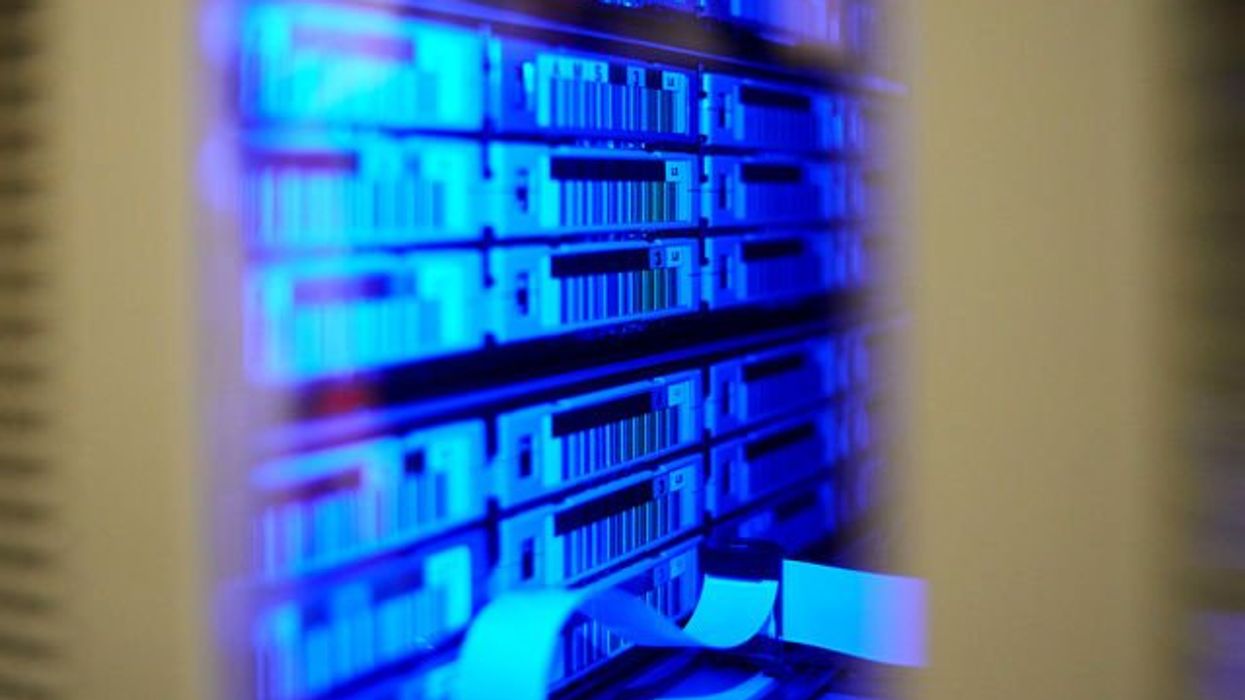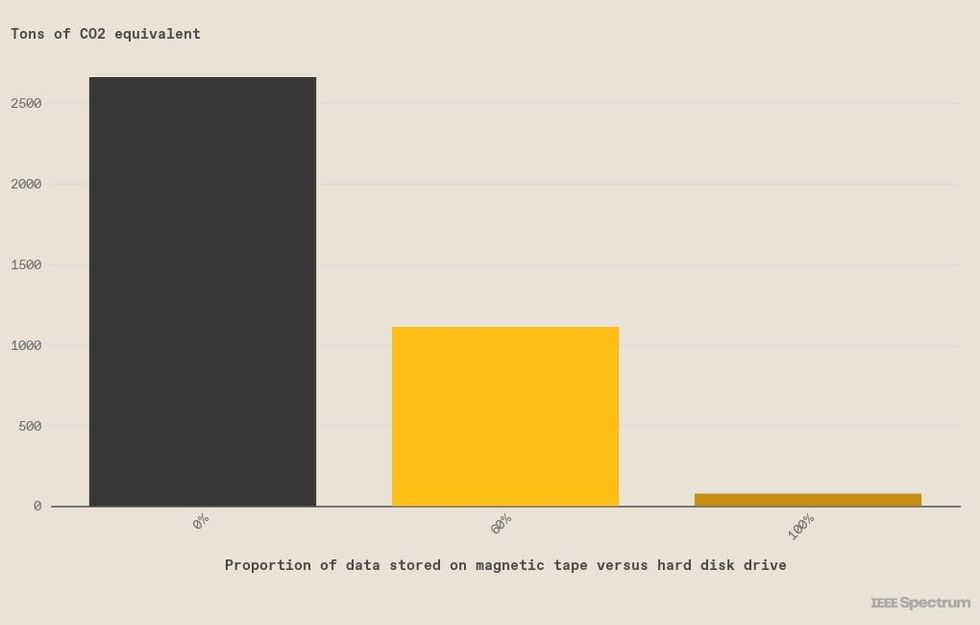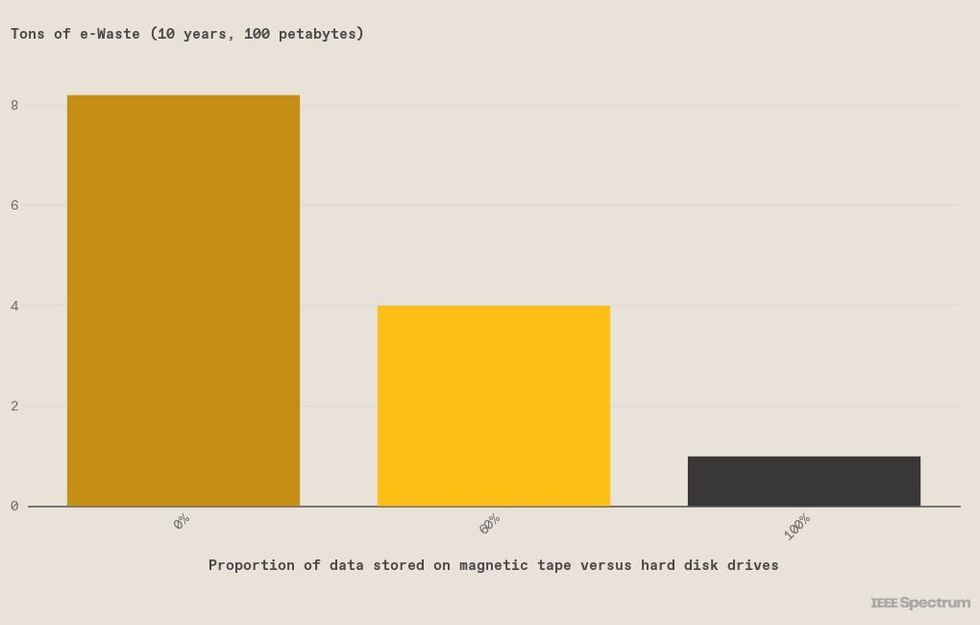Tape Storage Might Be Computing’s Climate Savior

This article is part of our exclusive IEEE Journal Watch series in partnership with IEEE Xplore.
Data storage has long contributed a significant portion of the computing industry's carbon footprint, even representing as much as 1.8 percent of the United States' total electricity consumption in 2014, according to a report by the Berkeley National Laboratory. Brad Johns, a veteran of IBM's data-storage business and a data-storage consultant in Arizona, believes that the solution to data-storage sustainability, for the foreseeable future at least, lies in a piece of technology many might consider already outdated: the magnetic data tape.
There's an opportunity that many organizations have to reduce their carbon footprint and do it in a way that could reduce their costs.... That's kind of a win-win," says Johns.
At least 60 percent of all data is cold," yet remains on hard disks. Which presents an opportunity to transition to a greener-and cheaper-alternative.
The need for data storage is only growing, too. International Data Corp. (IDC) estimated that the total amount of data created would increase from 33 zettabytes in 2018 to 175 ZB in 2025, and that around 10 percent, or 17 ZB, of that data would be stored in 2025. According to estimates by IDC and Seagate cited in 2021, 62 percent of data is stored on hard disks, 9 percent on solid state drives (SSDs), and 15 percent on tape in 2021.
Hard disks are more convenient for storage because information can be retrieved from them much faster than it can be retrieved from tape storage. The trade-off is higher carbon emissions, Johns explains in an article for Motion Image Journal-hard disks have a life span of approximately five years, during which time they produce around 2.55 equivalent kilograms of carbon dioxide per terabyte per year (based on an estimate from Seagate for the Exos X18 hard disk). In contrast, tape media has a life span of more than 30 years, during which time they produce just 0.07 kg CO2/TB/year (based on an estimate from Fujifilm for the LTO 9 ), or 3 percent that of hard disks.
Tape Storage Saves Carbon
 The bars on this graph indicate the climate savings accrued in switching out cold" data (data rarely accessed but still indisposable) from hard drives to magnetic tape. Source: Brad Johns Consulting
The bars on this graph indicate the climate savings accrued in switching out cold" data (data rarely accessed but still indisposable) from hard drives to magnetic tape. Source: Brad Johns Consulting
Johns points out that most of the enormous influx of information being created and stored today is cold data," data that is rarely accessed but still has value and cannot be discarded. According to a 2019 white paper by IDC, 60 percent of all data is cold, yet remains on hard disks. Johns argues that this presents an important opportunity for big data corporations to transition to an alternative, tape storage, a more sustainable form of data storage which would reduce their carbon footprint.
If organizations worldwide collectively transitioned all their cold data, a collective 60 percent of all data, to tape, the amount of carbon dioxide emitted by data storage across the globe would fall by 58 percent, a 79 million ton reduction in CO2 emissions, Johns calculates.
Reducing e-WasteTape Storage Saves e-Waste
 Meanwhile, this graph indicates how much e-waste is also saved by switching a portion of the world's cold" stored data from hard disks to magnetic tape. Source: Brad Johns Consulting
Meanwhile, this graph indicates how much e-waste is also saved by switching a portion of the world's cold" stored data from hard disks to magnetic tape. Source: Brad Johns Consulting
Transitioning cold data to be stored on modern tape media also reduces electronic waste (e-waste). Since hard disks only have a five-year life span, the old hard disks will need to be discarded for new ones to retain the same data. Tape storage is typically replaced every 10 years, resulting in less discarded storage. As an example, if a data center needs to store 100 petabytes of data for 10 years, storing all data on hard disks results in 7.4 tonnes of e-waste. If 60 percent of the data is moved to tape, only 3.6 tonnes of e-waste are generated, resulting in a 51 percent reduction.
Tape today clearly has a compelling advantage over hard disk drives. And if you look at the road maps, it's going to stay that way probably for the next decade."
-Brad Johns, Brad Johns Consulting
Further incentive for this solution is the financial benefit, argues Johns. Using Fujifilm's total cost of ownership (TCO) tool, he calculated that storing all 100 PB of data on hard disk costs US $17,707,468, while a mix that includes 60 percent tape cuts the cost nearly in half to $9,476,339.
Many big corporations have already started shifting toward tape storage. For smaller companies, however, the process of shifting to tape has been slower. The definition of cold data is variable, and depends on individual organizations' needs and user requirements. Thus, categorizing data as cold" so that it can be moved to tape is tricky--and costs time, money, and effort. While large corporations may have these resources, smaller companies do not. This is one of the obstacles preventing tape storage from being widely implemented in smaller scale data centers.
The other obstacle Johns describes is the management challenge. The technology is pretty proven. It's just trying to get the momentum amongst all the other things that IT organizations have to do," he says.
Regardless of whether corporations implement the solution, the question remains whether tape storage is the solution that is here to stay. Tape today clearly has a compelling advantage over hard disk drives, and if you look at the road maps, it's going to stay that way probably for the next decade," says Johns. But there is active research into alternatives. Microsoft, for example, has invested in research for DNA-based storage options, he points out. But, there's still a lot of research to be done and engineering to actually turn it into something," he says.